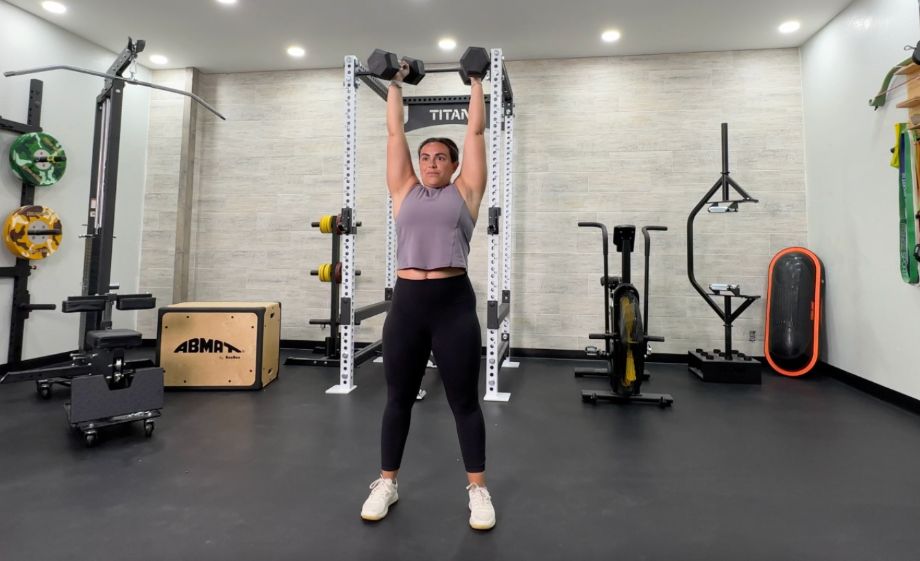We test and review fitness products based on an independent, multi-point methodology. If you use our links to purchase something, we may earn a commission. Read our disclosures.
Regular strength training is a surefire way to build muscle and contribute to a muscular physique, but it’s about much more than looks for many fitness enthusiasts—it’s important for your overall health and well-being.
According to a 2012 study1 published in Current Sports Medicine Reports, “benefits of resistance training include improved physical performance, movement control, walking speed, functional independence, cognitive abilities, and self-esteem.”
We’ve put together one of the best arm workouts with weights that hits all the major upper body muscle groups, so you can start reaping the rewards of resistance training starting today!
Upper-Body Anatomy
What muscles will be featured in our upper body workout?
Chest
The pectoralis major and minor, serratus anterior, and subclavius, which make up your chest muscles2, enable various arm movements, from “flexion, adduction, and internal rotation of the humerus.”
A strong chest will do more for you than simply make you look buff. According to a 2022 study3 published in the International Journal of Environmental Research and Public Health, chest strengthening exercises also improve “respiratory muscle strength [and] lung function,” making it worthwhile whether you’re a self-proclaimed “meathead” or not.
Back
There’s a lot going on when it comes to your back muscles4.
You’ve got extrinsic back muscles5, like the trapezius, rhomboids, and latissimus dorsi, that facilitate various movements that originate from the shoulder girdle, but they also support the head and neck.
Then there are the intrinsic back muscles, like the erector spinae in the lower back, which are integral for lifting and carrying objects. They also assist in maintaining an upright posture.
Shoulders
Strong shoulder muscles6 give you a confident appearance, but there are loads of functional benefits associated with shoulder strength, from sport-specific actions to activities of daily living.
Extrinsic shoulder muscles, like your traps and levator scapulae, enable movement of the shoulder blades, while the intrinsic shoulder muscles, like the deltoids and the rotator cuff muscles, facilitate movement within the shoulder joint.
Movements ranging from throwing a baseball to passing the mashed potatoes at the dinner table rely on your shoulder muscles.
Biceps
The biceps consist of the coracobrachialis, brachialis, and biceps brachii7.
Some folks wrongfully believe that the biceps are just a “pretty muscle” that provide little functional benefit. In truth, the biceps assist elbow flexion, a very common movement. So strong biceps are for much more than just doling out two tickets to the “gun show!”
Triceps
Your triceps8 are the other muscle group of your upper arm, and they’re responsible for extending the forearm at the elbow joint, making them an antagonist pair with the biceps.
You’ll recruit your triceps, along with your chest muscles, whenever you’re pushing something with your arms, whether that’s an opponent during a sports match, a heavy door you’re trying to open, or a piece of furniture in your home.
Forearms
Most arm workouts focus on the biceps and triceps, but your forearm muscles9 are just as important. Strong forearms contribute to more muscular appearance, but also improve grip strength that translates nicely to sport-specific activities, like weightlifting and rock climbing, as well as the activities of daily living.
Best Arm Exercises with Weights
We couldn’t call it the best arm workout if it didn’t include all the basic arm movements.
We’ve incorporated pushing movements, pulling movements, shoulder flexion, overhead pressing, and forearm exercises, too!
Get in your warm-up, grab a pair of dumbbells, and let’s do this!
RELATED: Best Dumbbells
1. Dumbbell Overhead Press
Why it’s great: The overhead press, military press, strict press, shoulder press—whatever you want to call it, this one is your fundamental all-purpose shoulder strength movement.
How to do it:
- Stand while holding two dumbbells at shoulder height.
- Press the weights over your head until your elbows reach lockout.
- Slowly bring them back down to the starting position.
- Repeat as needed.
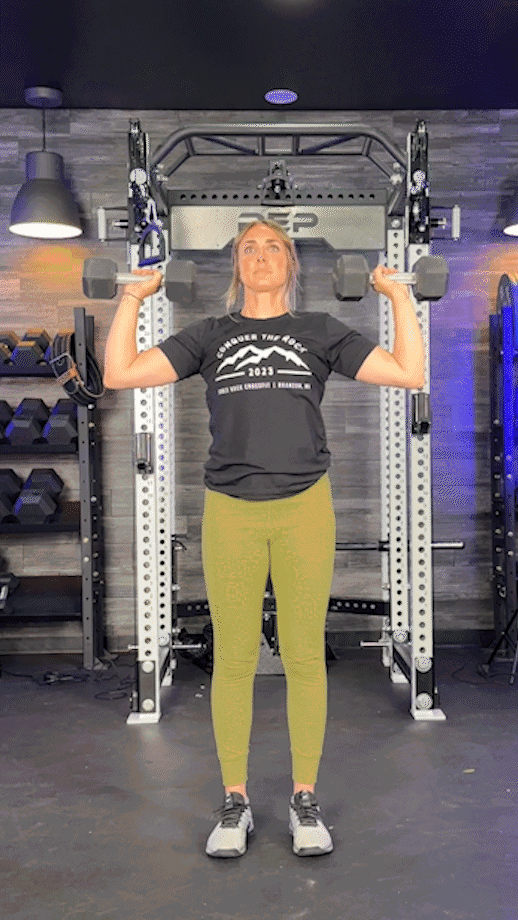
2. Dumbbell Bench Press
Why it’s great: The barbell bench press is the chest workout staple, but swapping the barbell for dumbbells increases the range of motion, providing more muscle activation in the process.
How to do it:
- Sit down at the edge of a bench, holding a dumbbell on each thigh near the knee.
- Lie back, simultaneously pushing each dumbbell into the air with your thighs. You should ultimately position them directly over your chest.
- Lower the dumbbells to your sternum until your elbows are in line with your torso.
- Push them back to the peak position.
- Repeat as needed.
RELATED: The Dumbbell Bench Press
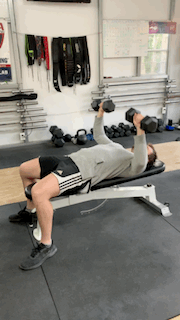
3. Dumbbell Fly
Why it’s great: Most chest-building exercises involve pushing, but the dumbbell fly relies on adduction, or bringing the weights toward the midline, for a serious pec, delt, and biceps pump.
How to do it:
- Lie flat on a bench with a dumbbell held in each hand using a neutral grip. Your arms should be fully extended with a slight bend in the elbow to protect the joint.
- Slowly lower your arms out and to your sides with control.
- From the bottom, bring your arms back together by reversing the motion. Squeeze your pecs at the top of the movement.
- Repeat as needed.
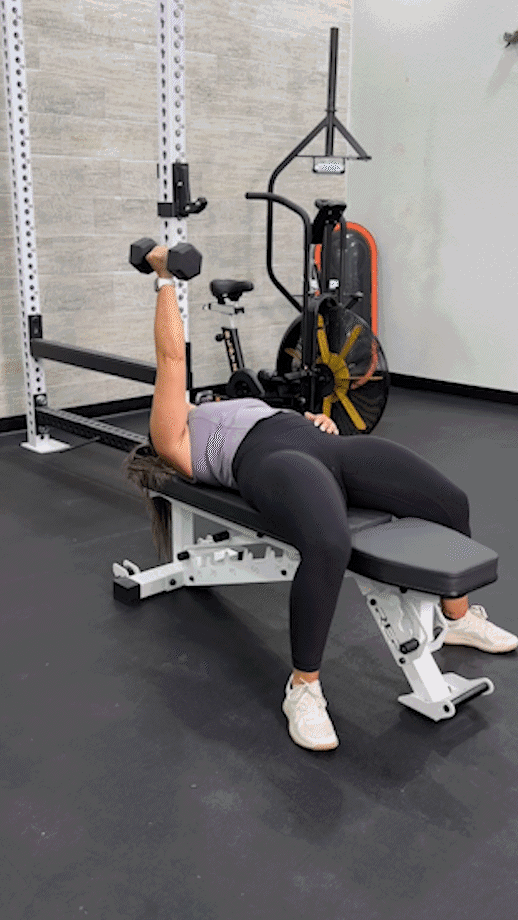
4. Reverse Dumbbell Fly
Why it’s great: If we take our dumbbell fly movement pattern and flip it, you’ll get the reverse dumbbell fly, which hits the posterior deltoids, rhomboids, and trapezius, making them a great pick for an all-inclusive upper body workout.
How to do it:
- Stand with your feet shoulder-width apart while holding two dumbbells with your palms facing each other. Lean forward from your hips, keeping your back straight, until your chest is nearly parallel with the ground. Extend your arms toward the ground.
- Pull the dumbbells out to the sides, pinching your shoulder blades together at the end.
- Slowly bring the weights back to the starting position.
- Repeat as needed.
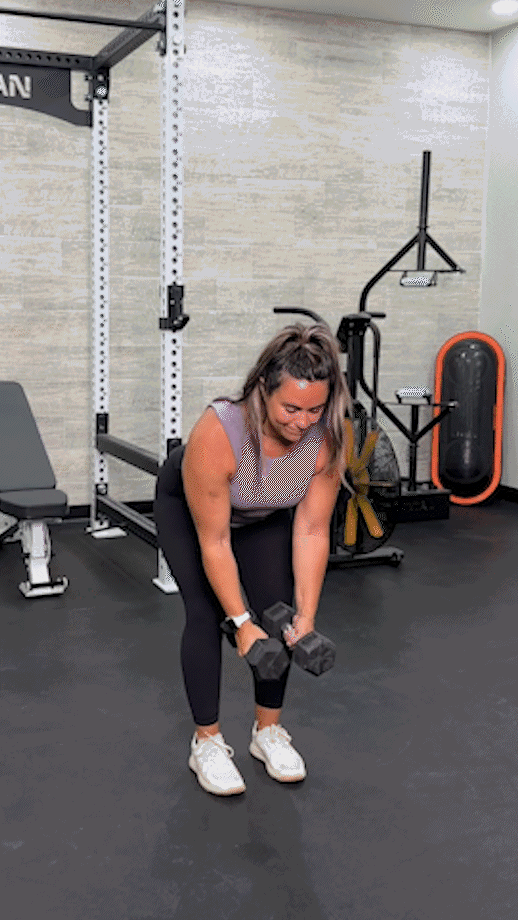
5. Standing Biceps Curl
Why it’s great: No dumbbell arm workout is complete without working in some biceps curls! The standing version provides great activation in the biceps, but also hits your core to improve trunk stability.
How to do it:
- Hold two dumbbells in front of your body using an underhand grip.
- Brace your core and curl the dumbbells to your shoulders, keeping your elbows pinned to your torso.
- Slowly return the weights to the starting position.
- Repeat as needed.
RELATED: 7 Best Dumbbell Curl Variations
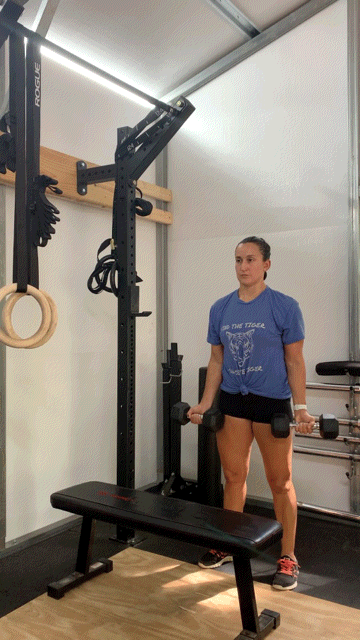
6. Seated Biceps Curl
Why it’s great: We love the standing version due to the activation you get in your core muscles, but the seated version keeps the focus where it should be—the biceps!
How to do it:
- Sit down at the edge of a bench. You may use two dumbbells simultaneously or one dumbbell to do single-arm curls instead. Keep your elbows pinned to your torso.
- Curl the weights to your shoulders, squeezing your biceps at the end.
- Slowly return to the starting position.
- Repeat as needed.
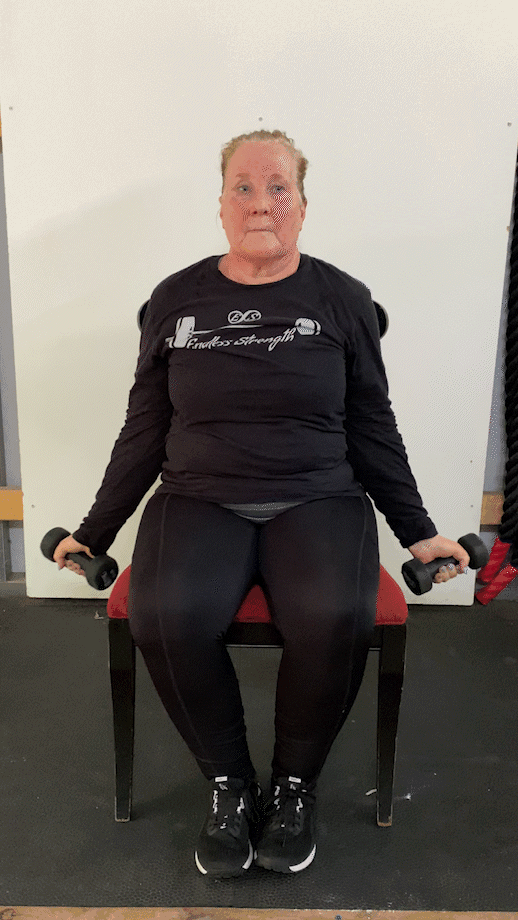
7. Standing Triceps Extension
Why it’s great: The standing triceps extension is one of the few dumbbell arm exercises, along with the triceps kickback, that isolates the triceps.
How to do it:
- Stand with your feet hip-width apart while holding a dumbbell straight overhead.
- Bend your elbow to lower the weight behind your head. Your upper arm should remain vertical and stationary as you move.
- Bring the weight back overhead by reversing the movement.
- Repeat as needed.
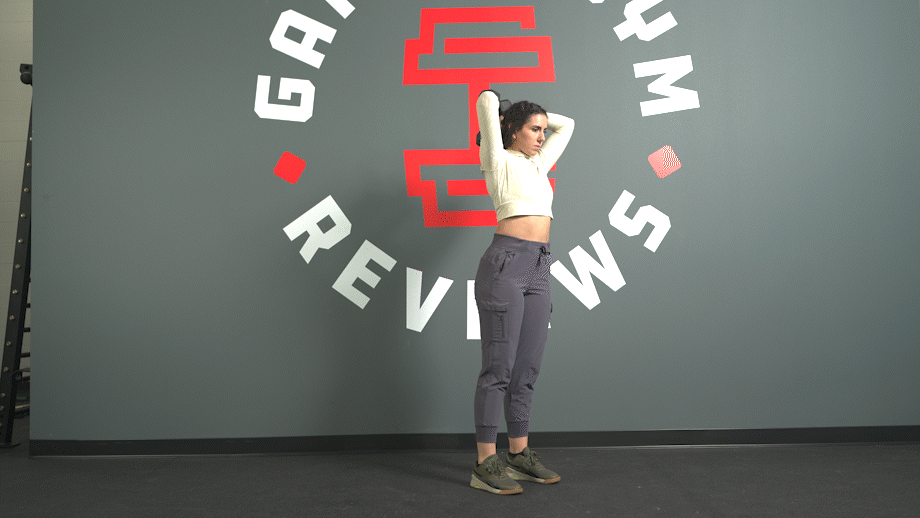
8. Overhead Triceps Extension
Why it’s great: The overhead triceps extension is like a standing or seated skull crusher. Performing it from a seated position lets you to really target the triceps, making it one of the best triceps exercises around.
How to do it:
- Sit down at the end of a bench, holding a heavy dumbbell overhead with both hands. Your arms should be fully extended, save for a slight bend in the elbow.
- Slowly lower the weight behind your head by bending the elbows.
- Push the dumbbell back overhead.
- Repeat as needed.
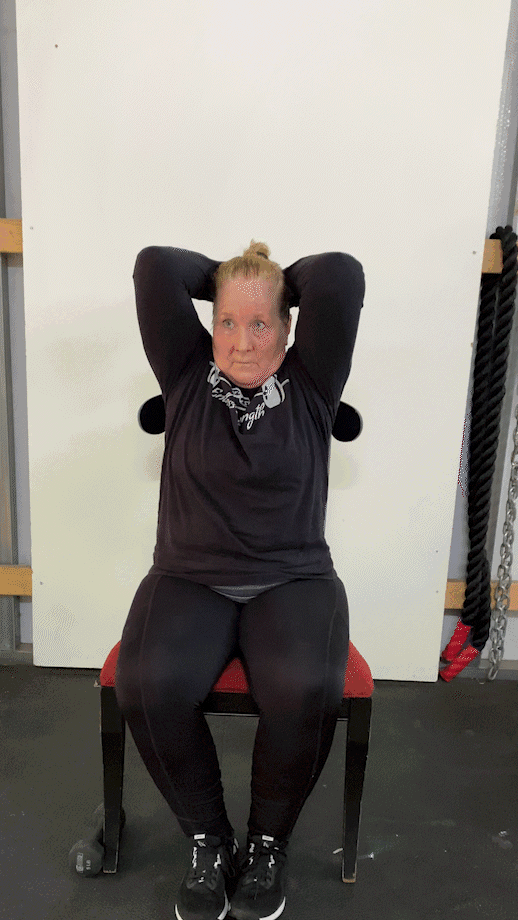
9. Front Raise
Why it’s great: Front raises use shoulder flexion to isolate the deltoids. We recommend using lighter weight for these, as holding the dumbbells far from the body makes them feel more challenging than they would for exercises like the biceps curl where the weights are held close.
How to do it:
- Hold a pair of dumbbells in front of your body using an overhand grip.
- Moving from the shoulder joint, bring your arms up until they are at shoulder height.
- Slowly return to the starting position.
- Repeat as needed.
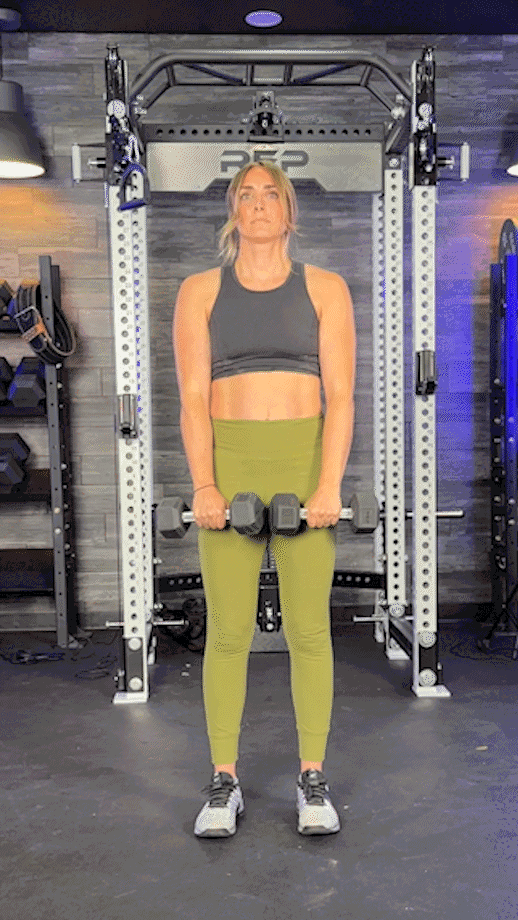
10. Lateral Raise
Why it’s great: Lateral raises are fantastic for targeting the deltoids, specifically the lateral deltoids on the sides. This contributes to a nice well-rounded appearance, as well as strength improvements in your shoulders.
How to do it:
- Hold dumbbells on each side of your body.
- Raise your arms up and out until they reach shoulder level.
- Slowly bring the weights back down to your sides.
- Repeat as needed.
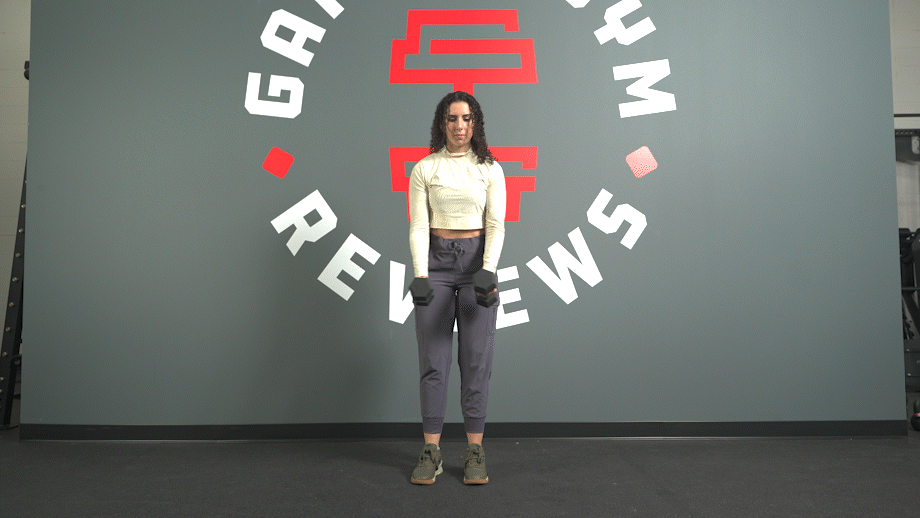
11. Forearm Curls
Why it’s great: Also called “wrist curls,” the forearm curl is a very slight movement that engages your forearm extensors and flexors for improved wrist mobility and grip strength.
How to do it:
- Sit on a weight bench, placing your elbows on your knees for support. Let your hands dangle, holding light dumbbells.
- Slightly curl the weights toward the body, then downward toward the floor. It’s a small range of motion, but you should move slowly to avoid strain.
- Perform the number of desired repetitions.
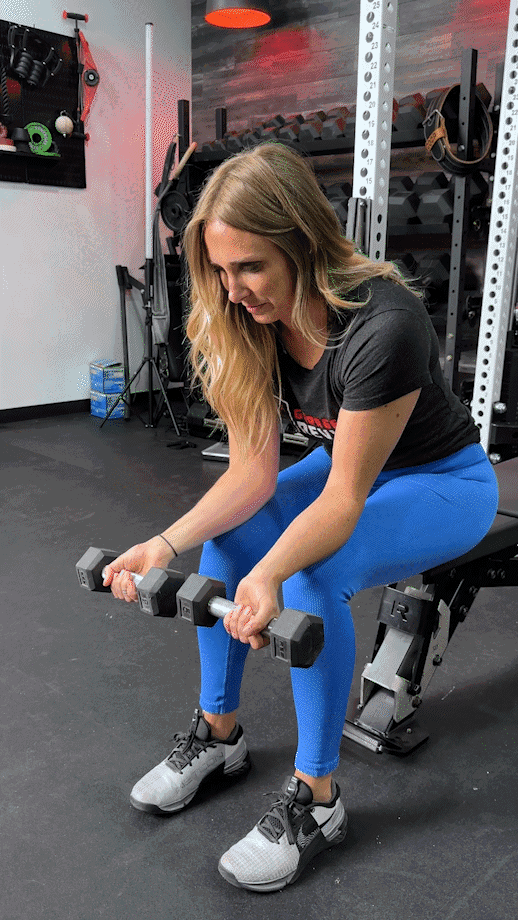
How Many Reps and Sets to Do During an Arm Workout
So, we have a great list of dumbbell arm exercises, but how many reps to build muscle? What if our goal is to build strength instead? How do we put it together into a workout that gets results?
For our answers, we turn to Kate Meier, CPT and GGR Head of Content.
“How to structure your workout all depends on your personal goals,” Kate says.
For strength gains, Kate recommends keeping the number of sets and reps low, approximately two to five, but selecting weights that challenge you on every rep. We’re talking 80% of your one-rep max, which will feel very difficult even on rep number one!
If you’re more into building muscle mass, a moderate number of sets and reps is the way to go. Kate recommends three to five sets of eight to 12 reps using a weight that’s between 60% and 75% of your max. The first few reps might feel easy, but the last few are gonna hurt!
Finally, Kate recommends only two sets if your goal is muscular endurance, but you’re going to rack up double-digits on the reps! We’re talking between 15 and 30 reps using a weight that’s around 40% your max.
Regarding exercise order and selection, studies show10 you get the most benefit from exercises you perform at the beginning of your workout. So, make sure you choose compound exercises that target various muscle groups, like the overhead press and chest press, early in your session, finishing with isolation exercises, like raises and curls.
FAQs: Arm Workouts with Weights
What is a good arm workout with weights?
There are plenty of ways to put our dumbbell arm exercises together into a cohesive workout. For personalized programming, consider working with a certified personal trainer or other fitness professional.
Here is a sample workout using our above exercises. Perform all exercises using moderate weight, roughly 60% to 75% of your one-rep max, and take approximately 2 minutes of rest in between sets and exercises.
Dumbbell chest press 5 sets, 8-12 reps
Dumbbell overhead press 5 sets, 8-12 reps
Standing biceps curl 5 sets, 8-12 reps
Standing triceps extension 5 sets, 8-12 reps
Front raises 4 sets, 12-15 reps
Can weights tone arms?
Resistance training increases muscle mass, which contributes to that classic “Greek statue” look, but it’s not the only thing you’ll need to sculpt such an appearance.
Supplement your arm workouts by strength training other muscle groups, performing cardio cardio, eating right, and getting enough rest each night.
How can I build arm muscle fast?
There are no shortcuts in fitness, but incorporating our above exercises into your strength training routine is a good place to start.
Working with a certified personal trainer, fitness professional, health coach, and/or certified nutritionist can also help you fast-track your results.
Can I work arms every day?
It’s generally not a good idea, as muscles need between 24 and 48 hours to recover fully. Luckily, you’ll still get great results, even if you’re not hitting your arms six times a week.
A 2018 study published in the Journal of Strength and Conditioning Research11 found that “increased training frequency does not lead to additional strength improvements when volume and intensity are equated.”
Simply put, as long as you’re doing enough during each session, you don’t have to race back to the gym and do it again. Instead of training frequency, focus on volume and intensity, and you should still get results!
References
1. Westcott WL. Resistance training is medicine: effects of strength training on health. Curr Sports Med Rep. 2012;11(4):209-216. doi:10.1249/JSR.0b013e31825dabb8
2. Baig MA, Bordoni B. Anatomy, Shoulder and Upper Limb, Pectoral Muscles. [Updated 2022 Aug 30]. In: StatPearls [Internet]. Treasure Island (FL): StatPearls Publishing; 2023 Jan
3. Azab AR, Abdelbasset WK, Alrawaili SM, et al. Effect of Chest Resistance and Expansion Exercises on Respiratory Muscle Strength, Lung Function, and Thoracic Excursion in Children with a Post-Operative Congenital Diaphragmatic Hernia. Int J Environ Res Public Health. 2022;19(10):6101. Published 2022 May 17. doi:10.3390/ijerph19106101
4. Henson B, Kadiyala B, Edens MA. Anatomy, Back, Muscles. [Updated 2022 Aug 25]. In: StatPearls [Internet]. Treasure Island (FL): StatPearls Publishing; 2023 Jan
5. Mitchell B, Imonugo O, Tripp JE. Anatomy, Back, Extrinsic Muscles. [Updated 2022 Aug 25]. In: StatPearls [Internet]. Treasure Island (FL): StatPearls Publishing; 2023 Jan
6. Javed O, Maldonado KA, Ashmyan R. Anatomy, Shoulder and Upper Limb, Muscles. [Updated 2022 Jul 25]. In: StatPearls [Internet]. Treasure Island (FL): StatPearls Publishing; 2023 Jan
7. Tiwana MS, Charlick M, Varacallo M. Anatomy, Shoulder and Upper Limb, Biceps Muscle. [Updated 2022 Aug 30]. In: StatPearls [Internet]. Treasure Island (FL): StatPearls Publishing; 2023 Jan
8. Tiwana MS, Sinkler MA, Bordoni B. Anatomy, Shoulder and Upper Limb, Triceps Muscle. [Updated 2022 Aug 30]. In: StatPearls [Internet]. Treasure Island (FL): StatPearls Publishing; 2023 Jan
9. Mitchell B, Whited L. Anatomy, Shoulder and Upper Limb, Forearm Muscles. [Updated 2022 Jun 14]. In: StatPearls [Internet]. Treasure Island (FL): StatPearls Publishing; 2023 Jan
10. Simão R, de Salles BF, Figueiredo T, Dias I, Willardson JM. Exercise order in resistance training. Sports Med. 2012;42(3):251-265. doi:10.2165/11597240-000000000-00000
11. Colquhoun RJ, Gai CM, Aguilar D, et al. Training Volume, Not Frequency, Indicative of Maximal Strength Adaptations to Resistance Training. J Strength Cond Res. 2018;32(5):1207-1213. doi:10.1519/JSC.0000000000002414
Further reading

The classic lat pulldown is great, but lat pulldown variations can alter the stimulus and add a little spice to your workout. Check out our expert guide right here! Read more

In this MapMyFitness Review, we’ll explain what makes this app one of the best options on the market for endurance athletes. Read more

Learn how to keep your machine in superior shape: how to lubricate a treadmill Read more

The EnergyFit SKI-ROW is a combination of both a rowing and skiing machine in one (semi) compact unit. The biggest consideration should be how it compares to the Concept 2 Model D Rower and Concept 2 SkiErg and after comparing the two, Concept 2’s machines are vastly superior. Although we like the novel idea of the SKI-ROW, we do think there are some issues that need to be addressed before we can fully recommend it. Read more

